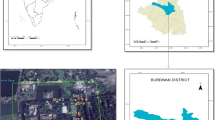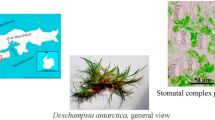Abstract
In this study, we assess the potential of white willow (Salix alba L.) as bioindicator for monitoring of air quality. Therefore, shoot biomass, specific leaf area, stomatal density, stomatal pore surface, and stomatal resistance were assessed from leaves of stem cuttings. The stem cuttings were introduced in two regions in Belgium with a relatively high and a relatively low level of air pollution, i.e., Antwerp city and Zoersel, respectively. In each of these regions, nine sampling points were selected. At each sampling point, three stem cuttings of white willow were planted in potting soil. Shoot biomass and specific leaf area were not significantly different between Antwerp city and Zoersel. Microclimatic differences between the sampling points may have been more important to plant growth than differences in air quality. However, stomatal pore surface and stomatal resistance of white willow were significantly different between Zoersel and Antwerp city. Stomatal pore surface was 20% lower in Antwerp city due to a significant reduction in both stomatal length (−11%) and stomatal width (−14%). Stomatal resistance at the adaxial leaf surface was 17% higher in Antwerp city because of the reduction in stomatal pore surface. Based on these results, we conclude that stomatal characteristics of white willow are potentially useful indicators for air quality.
Similar content being viewed by others
References
Balasooriya, B. L. W. K., Samson, R., Mbikwa, F., & Vitharana, U. W. A. (2009). Bio-monitoring of urban habitat quality by anatomical and chemical leaf characteristics. Environmental and Experimental Botany, 65(2–3), 386–394.
Broadmeadow, M. J., & Jackson, S. B. (2000). Growth responses of Quercus petraea, Fraxinus excelsior and Pinus sylvestris to elevated carbon dioxide, ozone and water. New Phytologist, 146(3), 437–451.
Calzoni, G. L., Antognoni, F., Pari, E., Fonti, P., Gnes, A., & Speranza, A. (2007). Active bio-monitoring of heavy metal pollution using Rosa rugosa plants. Environmental Pollution, 149(2), 239–245.
Carreras, H. A., Canas, M. S., & Pignata, M. L. (1996). Differences in responses to urban air pollutants by Ligustrum Ait. and Ligustrum lucidum Ait. f. Tricolor (rehd.). Environmental Pollution, 93(2), 211–218.
Dobbertin, M. (2005). Tree growth as indicator of tree vitality and of tree reaction to environmental stress: A review. European Journal of Forest Research, 124(4), 319–333.
Elagoz, V., Han, S. S., & Manning, W. J. (2006). Acquired changes in stomatal characteristics in response to ozone during plant growth and leaf development of bush beans (Phaseolus vulgaris L.) indicate phenotypic plasticity. Environmental Pollution, 140(1), 395–405.
Fares, S., Barta, C., Brilli, F., Centritto, M., Ederli, L., Ferranti, F. et al. (2006). Impact of high ozone on isoprene emission, photosynthesis and histology of developing Populus alba leaves directly or indirectly exposed to the pollutant. Physiological plantarum, 128(3), 456–465.
Fenger, J. (2009). Air pollution in the last 50 years—From local to global. Atmospheric Environment, 43(1), 13–22.
Franzaring, J., Klumpp, A., & Fangmeier, A. (2007). Active bio-monitoring of airborne fluoride near an HF producing factory using standardised grass cultures. Atmospheric Environment, 41(23), 4828–4840.
Fuhrer, J., Skarby, L., & Ashmore, M. R. (1997). Critical levels for ozone effects on vegetation in Europe. Environmental Pollution, 97(1–2), 91–106.
Gostin, I., & Ivanescu, L. (2007). Structural and morphological changes in leaves of Salix alba under air pollution effect. International Journal of Energy and Environment, 1(4), 219–226.
Honour, S. L., Bell, J. N. B., Ashenden, T. W., Cape, J. N., & Power, S. A. (2009). Responses of herbaceous plants to urbain air pollution: Effects on growth, phenology and leaf surface characteristics. Environmental Pollution, 157(4), 1279–1286.
Larcher, W. (2003). Physiological plant ecology: Ecophysiology and stress physiology of functional groups. Germany: Springer.
Mills, G., Hayes, F., & Harmens, H. (2007). ICP Vegetation experimental protocol for the ozone sub-programme. Natural Environment Research Council. Retrieved from http://icpvegetation.ceh.ac.uk.
Monaci, F., Moni, F., Lanciotti, E., Grechi, D., & Barglagi, R. (2000). Bio-monitoring of airborne metals in urban environments: New tracers of vehicle emission, in place of lead. Environmental Pollution, 107(3), 321–327.
Moraes, R. M., Klumpp, A., Furlan, C. M., Klimpp, G., Domingos, M., Rinaldi, M. C. S. et al. (2002). Tropical fruit trees as bioindicators of industrial air pollution in southeast Brazil. Environment International, 28(5), 367–374.
Nali, C., & Lorenzini, G. (2007). Air quality survey carried out by schoolchildren: An innovative tool for urban planning. Environmental Monitoring Assessment, 131(1–3), 201–210.
Novak, K., Skelly, J. M., Schaub, M., Krauchi, N., Hug, C., Landolt, W. et al. (2003). Ozone air pollution and foliar injury development on native plants of Switzerland. Environmental Pollution, 125(1), 41–52.
Olyslaegers, G., Nijs, I., Roebben, J., Kockelbergh, F., Vanassche, F., Laker, M. et al. (2002). Morphological and physiological indicators of tolerance to atmospheric stress in two sensitive and two tolerant tea clones in South Africa. Experimental Agriculture, 38, 397–410.
Reiling, K., & Davison, A. W. (1995). Effects of ozone on stomatal conductance and photosynthesis in populations of Plantago major L. New Phytologist, 129(44), 587–594.
Rennenberg, H., Herschbach, C., & Polle, A. (1996). Consequences of air pollution on shoot-root interactions. Journal of Plant Physiology, 148(3–4), 296–301.
Rey-Asensio, A., & Carballeira, A. (2007). Lolium perenne as a biomonitor of atmospheric levels of fluoride. Environmental International, 33(4), 583–588.
Sant’Anna-Santos, B. F., da Silva, L. C., Azevedo, A. A., & Aguiar, R. (2006). Effects of simulated acid rain on leaf anatomy and micromorphology of Genipa Americana L. (Rubiaceae). Brazilian Archives of Biology and Technology, 49(2), 313–321.
Spellerberg, I. F. (1998). Ecologiccal effects of roads and traffic: A literature review. Global Ecology and Biogeography, 7, 317–333.
Verma, A., & Singh, S. N. (2006). Biochemical and ultrastructural changes in plant foliage exposed to auto-pollution. Environmental Monitoring and Assessment, 120(1–3), 585–602.
Woodbury, P. B., & Laurence, J. A. (1994). Chronic ozone exposure alters the growth of leaves, stems and roots of hybrid Populus. Environmental Pollution, 85(1), 103–108.
Zvereva, E. L., Kozlov, M. V., & Haukioja, E. (1997). Stress responses of Salix borealis to pollution and defoliation. Journal of Applied Ecology, 34(6), 1387–1396.
Author information
Authors and Affiliations
Corresponding author
Rights and permissions
About this article
Cite this article
Wuytack, T., Verheyen, K., Wuyts, K. et al. The potential of biomonitoring of air quality using leaf characteristics of white willow (Salix alba L.). Environ Monit Assess 171, 197–204 (2010). https://doi.org/10.1007/s10661-009-1271-4
Received:
Accepted:
Published:
Issue Date:
DOI: https://doi.org/10.1007/s10661-009-1271-4




